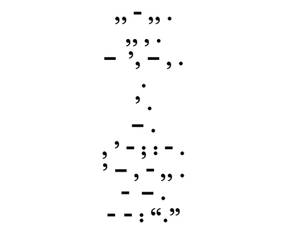Found Punctuation (Concrete Poetry)
|
||||||
|
Where,
where
where, where
avant-garde?
This is from the bone. the bone is a long process poem consisting of found punctuation. It is an exporation in form, structure and connections. The process removed allbut the ultimate and underlying formal structure. the bone is the second part of a series that is based on the words, punctuation, and space of Clement Greenberg’s article Avant-Garde and Kitsch. The first part was dog days. The bone was written and first published in 1997. A review by Eliot Weinberger in Sulfur 37 stated that the editor of one anthology had “‘normalized'” Emily Dickinson’s punctuation. Poems are more than words. Everyone’s structures are different, but sometimes they’re thrown to the dogs. . . , . , . – ? ? – -, . ,, .
My first foray into the world of punctuation started more than ten years ago when I reduced Clement Greenburg to his punctuation. That minimalist act was followed by research into the history of punctuation and just how it might be ‘read.’ A participation performance was first done at Beyond Baroque. A participation video is in about to be released. It is not a reenactment. The concrete poems and visuals were selected and designed specifically for this participation video. Historically, for a Roman orator’s use of punctuation was a very personal thing. He used his personal marks to tell him when to take a breath, what to emphasize, and when to stop talking. There was no upper or lower case, no space between words or punctuation in written texts. Then around 900 A.D., the Irish monks inserted those little marks into their illuminated manuscripts. Punctuation was complete formulized and peaked in it usage in the 1800s. By the early 1900s less and less punctuation was being used. The four concrete poems on my DVD are: Hollow Dog; Emily Dashing; Youth and Age and the puncturation from Duchamp’s SurcenSure. Hollow Dog is a poem that I assembled, in 1995, from the punctuation and the words that started with the letter h and d, from an essay written by artist Rosamond W. Purcell. In that article Purcell was discussing Allan Cullum work, where he made a cast of the missing dogs from the molds left by the dogs that died in Pompeii and the remains of Dutch dogs from World War II. She discusses his art and comments that she “missed the authentic object: the empty shell of the actual dog.” |
